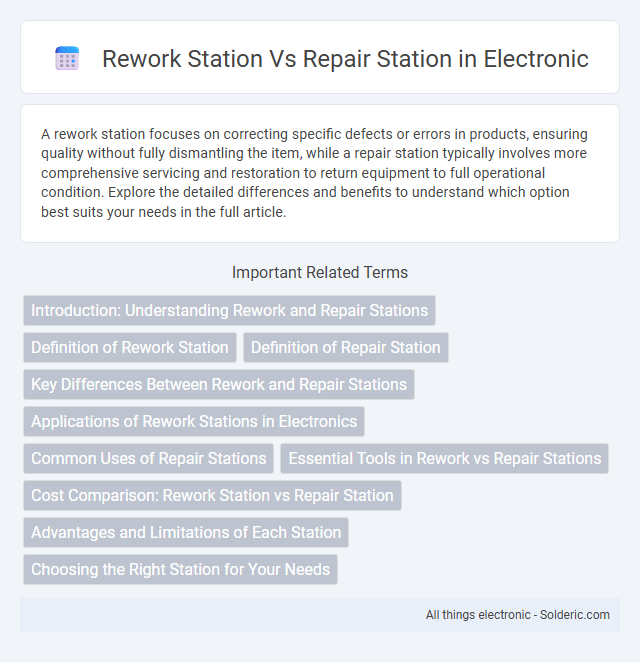A rework station focuses on correcting specific defects or errors in products, ensuring quality without fully dismantling the item, while a repair station typically involves more comprehensive servicing and restoration to return equipment to full operational condition. Explore the detailed differences and benefits to understand which option best suits your needs in the full article.
Comparison Table
| Feature | Rework Station | Repair Station |
|---|---|---|
| Primary Function | Corrects manufacturing defects by modifying or replacing components | Fixes operational or functional failures post-production |
| Typical Use | Adjust or re-solder components on PCBs during production | Restore functionality of products during maintenance or after failure |
| Equipment | Hot air guns, soldering irons, microscopes, flux applicators | Diagnostic tools, multimeters, oscilloscopes, repair toolkits |
| Process Focus | Component-level adjustments and replacements in controlled environment | System-level troubleshooting and part replacement |
| Typical Location | Manufacturing floor or assembly line | Service centers, field operations, or repair workshops |
| Skill Requirements | Highly skilled technicians in soldering and electronic assembly | Technicians trained in diagnostics, electronics, and mechanical repair |
| Outcome | Ensures product meets quality standards before shipment | Restores product to working condition after use or damage |
Introduction: Understanding Rework and Repair Stations
Rework stations specialize in correcting defects or modifying electronic components during the manufacturing process to ensure product quality and compliance with design specifications. Repair stations focus on diagnosing and restoring faulty electronic devices or equipment after use, extending their operational lifespan and reducing waste. Both stations play critical roles in electronics manufacturing and maintenance by minimizing downtime and improving reliability.
Definition of Rework Station
A rework station is a specialized workspace equipped for the process of correcting defects on printed circuit boards (PCBs) or electronic assemblies by removing and replacing faulty components. Unlike repair stations, which may perform a broader range of diagnostic and corrective actions, rework stations specifically target precise component-level interventions such as soldering, desoldering, and reflowing. This focused capability makes rework stations essential for maintaining high-quality electronics manufacturing standards and minimizing product failures.
Definition of Repair Station
A repair station is a certified facility authorized by aviation regulatory bodies such as the FAA to perform maintenance, preventive maintenance, and alterations on aircraft and aircraft components. Unlike rework stations that primarily focus on reconditioning or refurbishing parts to original specifications, repair stations ensure compliance with strict safety and regulatory standards during complex repairs. Your aircraft's airworthiness depends heavily on the reliability and certification status of the repair station handling its maintenance.
Key Differences Between Rework and Repair Stations
Rework stations primarily focus on correcting defects in electronic assemblies by removing and replacing faulty components, while repair stations handle broader equipment malfunctions and restoration tasks. Rework emphasizes precision soldering and component-level fixes, whereas repair stations typically involve troubleshooting and fixing functional issues across various system parts. The workflow in rework centers around circuit board-level corrections, contrasting with repair stations that may address mechanical, electrical, or software faults.
Applications of Rework Stations in Electronics
Rework stations are primarily used for precise soldering, desoldering, and component replacement on printed circuit boards (PCBs) in electronics manufacturing and repair. These stations enable efficient correction of defects, component upgrades, and testing, which enhances product reliability and extends device lifespan. If your project involves intricate PCB modifications or troubleshooting, a rework station provides the targeted heat control and fine manipulation required for successful electronics rework tasks.
Common Uses of Repair Stations
Repair stations are commonly used for routine aircraft maintenance, troubleshooting, and component overhauls to ensure compliance with regulatory standards. They specialize in inspecting, repairing, and certifying parts and systems to maintain airworthiness and safety. Your aircraft benefits from repair stations by receiving expert attention that minimizes downtime and enhances operational reliability.
Essential Tools in Rework vs Repair Stations
Essential tools in rework stations include precision soldering irons, hot air rework systems, soldering microscopes, and flux dispensers for effective component removal and replacement. Repair stations prioritize diagnostic equipment such as multimeters, oscilloscopes, and circuit testers alongside standard soldering tools to identify and fix a broader range of system faults. Both setups require anti-static mats and adjustable workbenches to ensure safety and ergonomic efficiency.
Cost Comparison: Rework Station vs Repair Station
Rework stations generally involve lower upfront costs compared to repair stations, as they focus on correcting specific assembly errors or component placements on circuit boards. Repair stations require more advanced diagnostics and labor-intensive processes, leading to higher operational expenses and extended downtime. Your choice between the two depends on balancing cost-efficiency with the complexity of repairs needed for your electronic components.
Advantages and Limitations of Each Station
A rework station excels at addressing minor soldering defects and component replacements with precision, enhancing efficiency and reducing waste, but it is limited by its inability to handle complex repairs requiring extensive diagnostics. In contrast, a repair station offers comprehensive troubleshooting capabilities and can manage intricate electronic repairs, though it typically involves longer turnaround times and higher operational costs. Choosing between the two depends on the specific repair complexity and production volume demands within electronics manufacturing and maintenance environments.
Choosing the Right Station for Your Needs
Selecting the right station depends on the specific nature of your task: a rework station is ideal for modifying or correcting solder joints and component placements on PCBs, ensuring precision and minimal damage. Repair stations focus on diagnosing and fixing electronic faults, offering specialized tools for component testing and replacement. Understanding the distinctions helps you choose a station that optimally supports your workflow and enhances productivity.
Rework station vs repair station Infographic

 solderic.com
solderic.com